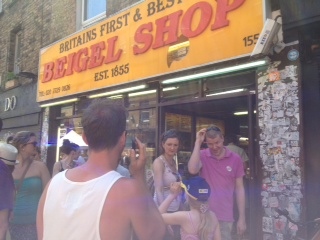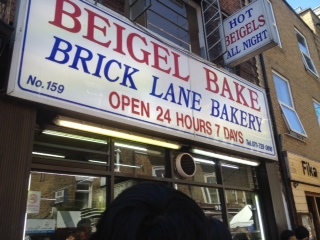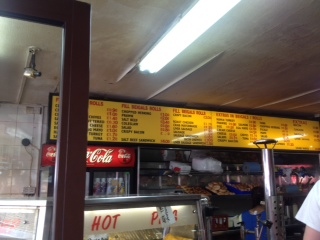A bagel by any other name?
We are in Spitalfields. Before Brick Lane was Banglatown it had been Jewish. Two outposts of the earlier ethnicity remain four doors apart on the same lively block. Each of them bakes bagels or, as they spell them, beigels, right on the premises.
The shops remind us in a way of Gino’s and Pat’s, the cheese steak stands that duel across a busy intersection of South Philadelphia. These best known (if not, however, best) emporia for the production of their respective street foods share not just a zip or postal code but the same sliver of turf within it.
A major difference does divide the Philadelphia cheese steak stands from the London beigel bakeries. It is numbers. By the arbitrary and unreliable count of Geoffrey Stokes (who still writes under the nom de ennui ‘Vladimir Estragon’ after some four decades; the joke has worn positively anorexic), 9,846 establishments in Philadelphia served cheese steaks as of 2007.
More than likely the count has only increased with the renewed popularity of local foodways. London, however, has no New York plethora of beigel shops; they sprinkle themselves through Golders Green and other Jewish parts of town, but not in their thousands nor even hundreds. The Spitalfields shops are special not just for their perpetual hours but for their relative perpetuity. They are survivors in a landscape otherwise transformed.

The shop at 155 Brick Lane bills itself as “Britain’s 1st and Best Beigel Shop” and claims its ancestry to 1855. Beigel Bake at number 159 makes no such claim on its signage but does boast that it opens 24 hours a day, seven days a week. Both are cheap: A plain beigel at either shop will set you back only something like 20 pence, or less than 35 cents.
No. 159 is famous not only for its beigels/bagels but also for salt (or corned) beef and, perhaps for that reason, garners considerably more comment at the top of an internet search. Each shop will split your beigel and fill it with just about anything, savory or sweet, spreadable or sliced. That will boost the cost by a multiple of the base price, but not by much in absolute terms. This is good street food at a bargain price.
Of a weekend they both sport long lines, longer at 155 during our several visits, but that may be the function of greater inefficiency rather than popularity. Staff at either storefront is brusque enough to remind you of Manhattan, but hardly mean; they work fast to fill your order and have little time for niceties.

We are here with New Yorkers, but not chauvinistic ones, to shop and eat and gaze, at all the Sunday markets in the Spitalfields shed and spilling through and off Brick Lane, into the sprawling wreck of the Truman Brewery and its surrounds. The hawkers fill Petticoat Lane too, and flowers fill Columbia Road. You can find eighteenth century kitchen manuscripts hidden in the conservatory behind the Town House, itself behind the Ten Bells, a busy public house across from Christ Church, the eerie, airy and powerful Hawksmoor masterpiece that took so long to build. Its innovative and unorthodox design that transformed classical elements into something unique caused consternation and engendered outrage at the time. The critics were fools.
There is street food and Canteen and St. John, the English Restaurant and, if you are lucky, the popup kitchen in play above Ten Bells. Is the name a reference to the endless Sunday peal from the quiet steeple next door?
If not quite a throwdown, our visit today does involve an element of competition. The New Yorkers have come not only to compare Brick Lane beigels, but also to determine whether a beigel bests their beloved bagel.
They found little difference between the 155 and 159 beigels. They both tasted good and each shared a pleasantly chewy but uniform texture. And that unfortunately is where they fall down compared to their New York City counterparts.

These London beigels are much like the impostors you find all over the United States outside the five boroughs of New York; good, but not, strictly speaking, really a bagel. Nobody would use ‘crunch’ to describe a bagel, but the best ones display some textural definition between inside and out. A good bagel’s brownish skin should pop when you take a bite, as it does at the best of New York bakeries, then feel chewy. Beigels, however, are all chew and no pop.
The New Yorkers’ judgment: A beigel is nothing to elicit shame in its baker but not worth a trip when you can get a bagel at home.
By the way we like Jim’s, itself a survivor on the traduced and now tacky South Street scene, for our Philadelphia cheese steaks and there, unlike Geno’s or Pat’s, they will sell you a beer.

